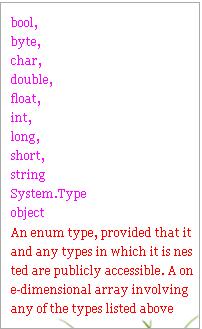这篇文章主要为大家展示了“C#中如何使用Attributes”,内容简而易懂,条理清晰,希望能够帮助大家解决疑惑,下面让小编带领大家一起研究并学习一下“C#中如何使用Attributes”这篇文章吧。
C# Attributes介绍
Attributes是一种新的描述信息,我们既可以使用attributes来定义设计期信息(例如 帮助文件,文档的URL),还可以用attributes定义运行时信息(例如,使XML中的元素与类的成员字段关联起来)。我们也可以用attributes来创建一个“自描述”的组件。
C# Attributes定义
MSDN 中做如下定义(ms-help://MS.MSDNQTR.2002APR.1033/csspec/html/vclrfcsharpspec_17_2.htm)
"An attribute is a piece of additional declarative information that is specified for a declaration."
使用预定义 Attributes
在c#中已有一小组预定义的attributes,在我们学习怎样创建自定义attributes前,先来了解下在我们的代码中使用那些预定义的attributes.
using System; public class AnyClass { [Obsolete("Don't use Old method, use New method", true)] static void Old( ) { } static void New( ) { } public static void Main( ) { Old( ); } }仔细看下该实例,在该实例中我们用到了”Obsolete”attribute,它标记了一个不该再被使用的语言元素(译者注:这里的元素为方法),该属性的***个参数是string类型,它解释为什么该元素被荒弃,以及我们该使用什么元素来代替它。实际中,我们可以书写任何其它文本来代替这段文本。第二个参数是告诉编译器把依然使用这被标识的元素视为一种错误,这就意味着编译器会因此而产生一个警告。
当我们试图编译上面的上面的程序,我们会得到如下错误:
AnyClass.Old()' is obsolete: 'Don't use Old method, use New method'
开发自定义Attributes
现在我们即将了解怎么开发自定义的attributes。这儿有个小小处方,有它我们就可以学会创建自定义的attributes。
在C#中,我们的attribute类都派生于System.Attribute类 (A class that derives from the abstract class System.Attribute, whether directly or indirectly, is an attribute class. The declaration of an attribute class defines a new kind of attribute that can be placed on a declaration) ,我们就这么行动吧。
using System; public class HelpAttribute : Attribute { }不管你是否相信我,就这样我们就已经创建了一个自定义attribute。现在就可以用它来装饰我们的类了,就像我们使用obsolete attribute一样。
[Help()] public class AnyClass { }注意:按惯例我们是用”Attribute“作为attribute类名的后缀,然而,当我们当我们把attribute绑定到某语言元素时,是不包含“Attribute“后缀的。编译器首先在System.Attribute 的继承类中查找该attribute,如果没有找到,编译器会把“Attribute“追加到该attribute的名字后面,然后查找它。
但是迄今为止,该attribute没有任何用处。为了使它有点用处,让我们在它里面加点东西吧。
using System; public class HelpAttribute : Attribute { public HelpAttribute(String Descrition_in) { this.description = Description_in; } protected String description; public String Description { get { return this.description; } } } [Help("this is a do-nothing class")] public class AnyClass { }在上面的例子中,我们在attribute类中添加了一个属性,在***一节中,我们将在运行时查询该属性。
定义或控制自定义Attribute的用法
AttributeUsage 类是另一预定义类(译者注:attribute类本身用这个atrribute System.AttributeUsage来标记),它将帮助我们控制我们自定义attribute的用法,这就是,我们能为自定义的attribute类定义attributes。
它描述了一个自定义attribute类能被怎样使用。
AttributeUsage 提供三个属性,我们能将它们放置到我们的自定义attribute类上, ***个特性是:
ValidOn
通过这个属性,我们能指定我们的自定义attribute可以放置在哪些语言元素之上。这组我们能把自定义attribute类放置其上的语言元素被放在枚举器AttributeTargets 中。我们可以使用bitwise(译者注:这个词不知道怎么翻译好,但他的意思是可以这么用:[AttributeUsage((AttributeTargets)4, AllowMultiple = false, Inherited = false )],4代表就是“class”元素,其它诸如1代表“assembly”,16383代表“all”等等)或者”.”操做符绑定几个AttributeTargets 值。(译者注:默认值为AttributeTargets.All)
AllowMultiple
该属性标识我们的自定义attribte能在同一语言元素上使用多次。(译者注:该属性为bool类型,默认值为false,意思就是该自定义attribute在同一语言元素上只能使用一次)
Inherited
我们可以使用该属性来控制我们的自定义attribute类的继承规则。该属性标识我们的自定义attribute是否可以由派生类继承。((译者注:该属性为bool类型,默认值为false,意思是不能继承)
让我们来做点实际的东西吧,我们将把AttributeUsage attribute 放置在我们的help attribute 上并在它的帮助下,我们来控制help attribute的用法。
using System; [AttributeUsage(AttributeTargets.Class, AllowMultiple = false, Inherited = false )] public class HelpAttribute : Attribute { public HelpAttribute(String Description_in) { this.description = Description_in; } protected String description; public String Description { get { return this.description; } } }首先我们注意 AttributeTargets.Class. 它规定这个help attribute 只能放置在语言元素”class”之上。这就意味着,下面的代码将会产生一个错误。
AnyClass.cs: Attribute 'Help' is not valid on this declaration type.
It is valid on 'class' declarations only.
现在试着把它绑定到方法。
[Help("this is a do-nothing class")] public class AnyClass { [Help("this is a do-nothing method")] //error public void AnyMethod() { } }我们可以使用 AttributeTargets.All 来允许 Help attribute 可以放置在任何预定义的语言元素上,那些可能的语言元素如下:

[Help("this is a do-nothing class")] [Help("it contains a do-nothing method")] public class AnyClass { [Help("this is a do-nothing method")] //error public void AnyMethod() { } }它产生了一个编译错误:
AnyClass.cs: Duplicate 'Help' attribute
Ok!现在我们该讨论下***那个属性了,”Inherited”, 指出当把该attribute放置于一个基类之上,是否派生类也继承了该attribute。如果绑定至某个attribute类的”Inherited”被设为true,那么该attribute就会被继承,然而如果绑定至某个attribute类的”Inherited”被设为false或者没有定义,那么该attribute就不会被继承。
让我们假设有如下的类关系。
[Help("BaseClass")] public class Base { } public class Derive : Base { }我们有四种可能的绑定:

***种情况
如果我们查询(我们将在后面来了解如何在运行时来查询attributes)派生类中的help attribute,我们将不可能查询到因为”Inherited”被设为了false。
第二种情况
第二种情况没有什么不同,因为其”Inherited”也被设为了false。
第三种情况
为了解释第三种和第四种情况,让我们为派生类也绑定同一attribute。
[Help("BaseClass")] public class Base { } [Help("DeriveClass")] public class Derive : Base { }现在我们查询相关的help attribute ,我们将仅仅可以得到派生类的attribute,为什么这样是因为help attribute虽然允许被继承,但不能多次在同一语言元素上使用,所以基类中的help attribute被派生类的help attribute 重写了。
第四种情况
在第四种情况中,当我们查询派生类的help attribute 时,我们可以得到两个attributes,当然是因为help attribute既允许被继承,又允许在同一语言元素上多次使用的结果。
注意:AttributeUsage attribute 仅应用在那种是System.Attribute 派生的attriubte类而且绑定值该attriubte类的AllowMultiple和Inherited均为false上才是有效的。
可选参数 vs. 命名参数
可选参数是attribute类构造函数的参数。它们是强制的,必须在每次在attribute绑定至某语言元素时提供一个值。而另一方面,命名参数倒是真正的可选参数,不是在attribute构造函数的参数。
为了更加详细的解释,让我们在Help类中添加另外的属性。
[AttributeUsage(AttributeTargets.Class, AllowMultiple = false, Inherited = false)] public class HelpAttribute : Attribute { public HelpAttribute(String Description_in) { this.description = Description_in; this.verion = "No Version is defined for this class"; } protected String description; public String Description { get { return this.description; } } protected String version; public String Version { get { return this.version; } //if we ever want our attribute user to set this property, //we must specify set method for it set { this.verion = value; } } } [Help("This is Class1")] public class Class1 { } [Help("This is Class2", Version = "1.0")] public class Class2 { } [Help("This is Class3", Version = "2.0", Description = "This is do-nothing class")] public class Class3 { }当我们在Class1中查询Help attribute已经它的属性,我们将得到:
Help.Description : This is Class1
Help.Version :No Version is defined for this class
因为我们没有为Version这个属性定义任何任何值,所以在构造函数中设定的值被我们查询出来了。如果没有定义任何值,那么就会赋一个该类型的默认值(例如:如果是int型,默认值就是0)。
现在,查询Class2的结果是:
Help.Description : This is Class2
Help.Version : 1.0
我们不能为了可选参数而使用多个构造函数,应该用已命名参数来代替。我们之所以称它们为已命名的,是因为当我们在构造函数为它们提供值时,我们必须命名它们。例如,在第二个类中,我们如是定义Help。
[Help("This is Class2", Version = "1.0")]
在 AttributeUsage 例子中, 参数”ValidOn”是可选参数,而“Inherited“和“AllowMultiple“ 是命名参数。
注意:为了在attribute的构造函数中设定命名参数的值,我们必须为相应的属性提供一个set方法否则会引起编译期错误:
'Version' : Named attribute argument can't be a read only property
现在,我们在Class3中查找Help attribute 及其属性会发生什么呢?结果是跟上面提到的相同的编译期错误。
'Desciption' : Named attribute argument can't be a read only property
现在我们修改下Help类,为属性”Description”加一个set方法。现在的输出就是:
Help.Description : This is do-nothing class
Help.Version : 2.0
在屏幕后面究竟发生了什么呢?首先带有可选参数的构造函数被调用,然后,每个命名参数的set方法被调用,在构造函数中赋给命名参数的值被set方法所覆写。
参数类型
一个attribute类的参数类型被限定在如下类型中:

Attributes 标记
假设,我们想把Help attribute 绑定至元素 assembly。***个问题是我们要把Help attribute 放在哪儿才能让编译器确定该attribute是绑定至整个assembly呢?考虑另一种情况,我们想把attribute绑定至一个方法的返回类型上,怎样才能让编译器确定我们是把attribute绑定至方法的返回类型上,而不是整个方法呢?
为了解决诸如此类的含糊问题,我们使用attribute标识符,有了它的帮助,我们就可以确切地申明我们把attribute 绑定至哪一个语言元素。
例如:
[assembly: Help("this a do-nothing assembly")]
这个在Help attribute 前的assembly标识符确切地告诉编译器,该attribute被绑定至整个assembly。可能的标识符有:

在运行时查询Attributes
现在我们明白怎么创建attribtes和把它们绑定至语言元素。是时候来学习类的使用者该如何在运行时查询这信息。
为了查询一语言元素上绑定的attributes,我们必须使用反射。反射有能力在运行时发现类型信息。
我们可以使用.NET Framework Reflection APIs 通过对整个assembly元数据的迭代,列举出assembly中所有已定义的类,类型,还有方法。
记住那旧的Help attribute 和AnyClass 类。
using System; using System.Reflection; using System.Diagnostics; //attaching Help attribute to entire assembly [assembly : Help("This Assembly demonstrates custom attributes creation and their run-time query.")] //our custom attribute class public class HelpAttribute : Attribute { public HelpAttribute(String Description_in) { // // TODO: Add constructor logic here this.description = Description_in; // } protected String description; public String Description { get { return this.deescription; } } } //attaching Help attribute to our AnyClass [HelpString("This is a do-nothing Class.")] public class AnyClass { //attaching Help attribute to our AnyMethod [Help("This is a do-nothing Method.")] public void AnyMethod() { } //attaching Help attribute to our AnyInt Field [Help("This is any Integer.")] public int AnyInt; } class QueryApp { public static void Main() { } }我们将在接下来的两节中在我们的Main方法中加入attribute查询代码。
查询程序集的Attributes
在接下来的代码中,我们先得到当前的进程名称,然后用Assembly类中的LoadForm()方法加载程序集,再有用GetCustomAttributes()方法得到被绑定至当前程序集的自定义attributes,接下来用foreach语句遍历所有attributes并试图把每个attribute转型为Help attribute(即将转型的对象使用as关键字有一个优点,就是当转型不合法时,我们将不需担心会抛出异常,代之以空值(null)作为结果),接下来的一行就是检查转型是否有效,及是不是为空,跟着就显示Help attribute的“Description”属性。
class QueryApp { public static void Main() { HelpAttribute HelpAttr; //Querying Assembly Attributes String assemblyName; Process p = Process.GetCurrentProcess(); assemblyName = p.ProcessName + ".exe"; Assembly a = Assembly.LoadFrom(assemblyName); foreach (Attribute attr in a.GetCustomAttributes(true)) { HelpAttr = attr as HelpAttribute; if (null != HelpAttr) { Console.WriteLine("Description of {0}:\n{1}", assemblyName,HelpAttr.Description); } } } }程序输出如下:
Description of QueryAttribute.exe:
This Assembly demonstrates custom attributes creation and
their run-time query.
Press any key to continue
查询类、方法、类成员的Attributes
下面的代码中,我们惟一不熟悉的就是Main()方法中的***行。
Type type = typeof(AnyClass);
它用typeof操作符得到了一个与我们AnyClass类相关联的Type型对象。剩下的查询类attributes代码就与上面的例子是相似的,应该不要解释了吧(我是这么想的)。
为查询方法和类成员的attributes,首先我们得到所有在类中存在的方法和成员,然后我们查询与它们相关的所有attributes,这就跟我们查询类attributes一样的方式。
class QueryApp { public static void Main() { Type type = typeof(AnyClass); HelpAttribute HelpAttr; //Querying Class Attributes foreach (Attribute attr in type.GetCustomAttributes(true)) { HelpAttr = attr as HelpAttribute; if (null != HelpAttr) { Console.WriteLine("Description of AnyClass:\n{0}", HelpAttr.Description); } } //Querying Class-Method Attributes foreach(MethodInfo method in type.GetMethods()) { foreach (Attribute attr in method.GetCustomAttributes(true)) { HelpAttr = attr as HelpAttribute; if (null != HelpAttr) { Console.WriteLine("Description of {0}:\n{1}", method.Name, HelpAttr.Description); } } } //Querying Class-Field (only public) Attributes foreach(FieldInfo field in type.GetFields()) { foreach (Attribute attr in field.GetCustomAttributes(true)) { HelpAttr= attr as HelpAttribute; if (null != HelpAttr) { Console.WriteLine("Description of {0}:\n{1}", field.Name,HelpAttr.Description); } } } } }以上是“C#中如何使用Attributes”这篇文章的所有内容,感谢各位的阅读!相信大家都有了一定的了解,希望分享的内容对大家有所帮助,如果还想学习更多知识,欢迎关注亿速云行业资讯频道!
免责声明:本站发布的内容(图片、视频和文字)以原创、转载和分享为主,文章观点不代表本网站立场,如果涉及侵权请联系站长邮箱:is@yisu.com进行举报,并提供相关证据,一经查实,将立刻删除涉嫌侵权内容。